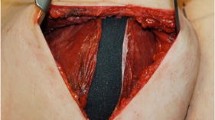Abstract
Background
The management of capsular contraction following breast augmentation has numerous, often conflicting potential treatment protocols, each designed to reduce the incidence of further recurrence. The use of the subfascial plane has not been investigated as an alternative to other treatment options.
Objectives
To examine the outcomes from patients presenting with recurrent capsular contraction after being treated for the first capsule by placement of an implant into the subfascial (SF) plane.
Methods
Retrospective analysis of 111 case notes of patients who presented with capsular contraction. 65 had undergone SF augmentation, 17 submuscular (SM) and 29 subglandular (SG) placement of implant at the primary procedure. At a secondary procedure, those with SF implants underwent open capsulotomy and those with SM and SG implants underwent a change in plane to SF.
Results
There is a significant difference in the proportion of patients that developed a capsule following the second surgery between the groups that had undergone capsulotomy (SF = 16.9%) or plane change (SM = 47% and SG = 37.9%, X2 (2,111) = 8.6, P = 0.02). When recurrence at the same site was examined, there was also a significant difference between the groups (X2 (2111) = 10.7, P < 0.01). A ruptured implant significantly increased the incidence of further capsular contraction when in the SG plane (X2 (2,29) = 12.1, P < 0.01).
Conclusions
In the absence of implant rupture, changing the plane of an implant to a SF position at revision surgery does not reduce the incidence of subsequent capsular contracture compared with open capsulotomy. Open capsulotomy is a reasonable choice following recurrence of capsular contraction following initial SF placement.
Level of Evidence IV
This journal requires that authors assign a level of evidence to each article. For a full description of these Evidence-Based Medicine ratings, please refer to the Table of Contents or the online Instructions to Authors www.springer.com/00266.


Similar content being viewed by others
References
Wan D, Rohrich RJ (2016) Revisiting the management of capsular contracture in breast augmentation: a systematic review. Plast Reconstr Surg 137(3):826–841
Adams WP Jr (2009) Capsular contracture: What is it? What causes it? How can it be prevented and managed? Clin Plast Surg 36(1):119–126
Chong SJ, Deva AK (2015) Understanding the etiology and prevention of capsular contracture: translating science into practice. Clin Plast Surg 42(4):427–436
Hidalgo DA, Sinno S (2016) Current trends and controversies in breast augmentation. Plast Reconstr Surg 137(4):1142–1150
Ajdic D, Zoghbi Y, Gerth D, Panthaki ZJ, Thaller S (2016) The relationship of bacterial biofilms and capsular contracture in breast implants. Aesthet Surg J 36(3):297–309
Brown T (2012) Subfascial breast augmentation: is there any advantage over the submammary plane? Aesthet Plast Surg. 36(3):566–569
Miller T (1998) Capsulectomy. Plast Reconstr Surg Reconstr Surg 102:882–883
Young VL (1998) Guidelines and indications for breast implant capsulectomy. Plast Reconstr Surg 102(3) 884–91. Discussion 892–4
Spear SL (1993) Capsulotomy, capsulectomy, and implantectomy. Plast Reconstr Surg 92(2):323–324
Swanson E (2016) Open capsulotomy: an effective but overlooked treatment for capsular contracture after breast augmentation. Plast Reconstr Surg Glob Open 4(10):e1096
Lee HK, Jin US, Lee YH (2011) Subpectoral and precapsular implant repositioning technique: correction of capsular contracture and implant malposition. Aesthet Plast Surg 35(6):1126–1132
Mladick RA (1977) Treatment of the firm augmented breast by capsular stripping and inflatable implant exchange. Plast Reconstr Surg 60(5):720–724
Maxwell GP, Birchenough SA, Gabriel A (2009) Efficacy of neopectoral pocket in revisionary breast surgery. Aesthet Surg J 29(5):379–385
Castello MF, Lazzeri D, Silvestri A, Agostini T, Pascone C, Marcelli C, Gigliotti D, D’Aniello C, Gasparotti M (2011) Maximizing the use of precapsular space and the choice of implant type in breast augmentation mammaplasty revisions: review of 49 consecutive procedures and patient satisfaction assessment. Aesthet Plast Surg 35(5):828–838
Baran CN, Peker F, Ortak T, Sensoz O, Baran NK (2001) A different strategy in the surgical treatment of capsular contracture: leave capsule intact. Aesthet Plast Surg 25(6):427–431
Xue H, Lee SY (2011) Correction of capsular contracture by insertion of a breast prosthesis anterior to the original capsule and preservation of the contracted capsule: technique and outcomes. Aesthet Plast Surg 35(6):1056–1060
Spear SL, Carter ME, Ganz JC (2003) The correction of capsular contracture by conversion to dual-plane positioning: technique and outcomes. Plast Reconstr Surg 112(2):456–466
Lesavoy MA, Trussler AP, Dickinson BP (2010) Difficulties with subpectoral augmentation mammaplasty and its correction: the role of subglandular site change in revision aesthetic breast surgery. Plast Reconstr Surg 125(1):363–371
Moufarrege R, Beauregard G, Bosse JP, Papillon J, Perras C (1987) Outcome of mammary capsulotomies. Ann Plast Surg 19(1):62–64
Hipps CJ, Raju R, Straith RE (1978) Influence of some operative and postoperative factors on capsular contracture around breast prostheses. Plast Reconstr Surg 61(3):384–389
Sugimoto T (1982) Open capsulotomy for capsular contracture: a new procedure for the prevention of recurrence. Aesthet Plast Surg 6(4):225–230
Herman S (1984) The même implant. Plast Reconstr Surg 73(3):411–414
Melmed EP (1990) Treatment of breast contractures with open capsulotomy and replacement of gel prostheses with polyurethane-covered implants. Plast Reconstr Surg. 86(2):270–274
Brown T, Brown S, Murphy T (2017) Breast durometer (mammometer): a novel device for measuring soft-tissue firmness and its application in cosmetic breast surgery. Aesthet Plast Surg. 41(2):265–274. https://doi.org/10.1007/s00266-017-0783-5
Murphy T, Brown S, Brown T (2020) A durometer (mammometer) for objective measurement capsular contraction following breast implant surgery. Am J Cosmet Surg. https://doi.org/10.1177/0748806820925722
Author information
Authors and Affiliations
Corresponding author
Ethics declarations
Conflict of interest
The author has no conflicts of interest to disclose.
Human and animal participants
Patients provided written consent to the study under the guiding principles outlined in the WMA Declaration of HELSINKI concerning ethical principles for medical research involving human subjects.
Additional information
Publisher's Note
Springer Nature remains neutral with regard to jurisdictional claims in published maps and institutional affiliations.
Rights and permissions
About this article
Cite this article
Brown, T. Plane Change Vs Capsulotomy: A Comparison of Treatments for Capsular Contraction in Breast Augmentation Using the Subfascial Plane. Aesth Plast Surg 45, 845–850 (2021). https://doi.org/10.1007/s00266-020-02010-8
Received:
Accepted:
Published:
Issue Date:
DOI: https://doi.org/10.1007/s00266-020-02010-8




